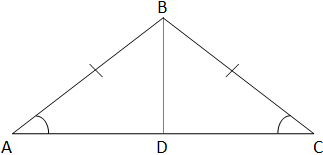Bunuel wrote:
What is the area of isosceles triangle X?
(1) The length of the side opposite the single largest angle in the triangle is 6cm
(2) The perimeter of triangle X is 16cm
Source: Platinum GMAT
Kudos for a correct solution.
Platinum GMAT Official Solution:In a triangle, the side opposite the largest angle will be the longest. Correspondingly, the side opposite the smallest angle will be the shortest.
Evaluate Statement (1) alone.The side opposite the single largest angle must be the single largest side in the triangle. Since an isosceles triangle contains two equal sides and two equal angles yet we know that a "single largest angle" exists, the side opposite the single largest angle cannot be one of these equal sides. If the longest side of an isosceles triangle were one of its equal sides, both angles opposite the equal sides would have equal measurement and there would be no single largest angle as Statement (1) indicates there must be.
The single largest side must be the base since the two other angles will have equivalent measurements and thus the length of the sides opposite them will be equivalent. The two equal sides must be less than 6cm (otherwise, the angle opposite the base would not be the single largest angle in the triangle). To reiterate, the two angles opposite the equivalent sides must be smaller than the angle opposite the base (otherwise the angle opposite 6cm side would not be the single largest angle).
The two equal sides must be longer than 3cm. Otherwise a closed triangle could not be formed (i.e., the lines would not connect).
Draw a diagram with the information we know:

AC = 6
3cm < AB < 6cm
3cm < BC < 6cm
Although we know the base, we know nothing about the height, BD. Without knowing that a definitive value for the height exists, we cannot calculate the area of the triangle.
Statement (1) is NOT SUFFICIENT.
Evaluate Statement (2) alone.Since triangle X is an isosceles triangle, the perimeter is formed by adding two equal sides and a third side. Set up an equation to reflect this:
2L + N = 16 where L is the length of the equivalent sides of the triangle and N is the length of the other side.
There are many different combinations of L and N that would give a different area. Assume that N is the base:
If N = 4 and L = 6, then the height of the triangle (via the Pythagorean theorem) would be the square root of 32, which is 5.65
If N = 5 and L = 5.5, then the height of the triangle (via the Pythagorean theorem) would be the square root of 24, which is 4.89.
Without being able to determine that a definitive value for the base and height exists, we cannot calculate the area of the triangle.
Statement (2) is NOT SUFFICIENT.
Evaluate Statements (1) and (2) together.Write equations that are derived from the information in both Statements:
(1) Base = 6cm
(2) 2L + B = 16
Combine the two equations:
2L + 6 = 16
L = 5
We now have a right triangle formed by half the base (AD = 3), the height (BD = unknown), and an equal side (AB = 5).

AC = 6
AD = 3
AB = BC = 5
Note: Since the triangle is isosceles, the height (or line BD) must perfectly bisect the base. This is because angles A and C are equal and sides AB and BC are equal. Further, angle D is right since it is the height and the height is by definition a right angle.
Through the Pythagorean theorem, BD must equal 4:
(AD)^2 + (BD)^2 = (AB)^2
9 + (BD)^2 = 25
(BD)^2 = 16
BD = 4
The area of triangle X must be (1/2)Base*Height = 3(4) = 12
Statements (1) and (2), when taken together, are SUFFICIENT.
Since Statement (1) alone is NOT SUFFICIENT and Statement (2) alone is NOT SUFFICIENT, but Statements (1) and (2), when taken together are SUFFICIENT, answer C is correct.Attachment:
 02062-1.gif [ 2.55 KiB | Viewed 8159 times ]
02062-1.gif [ 2.55 KiB | Viewed 8159 times ]



 15%
(low)
15%
(low)
 21%
(01:18)
wrong
21%
(01:18)
wrong  based on 111
sessions
based on 111
sessions

